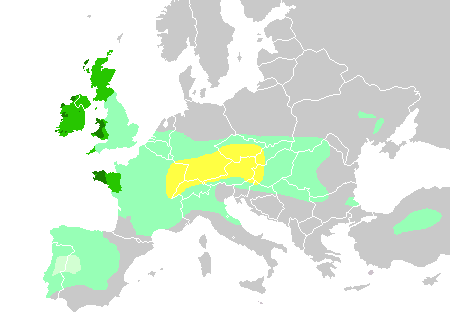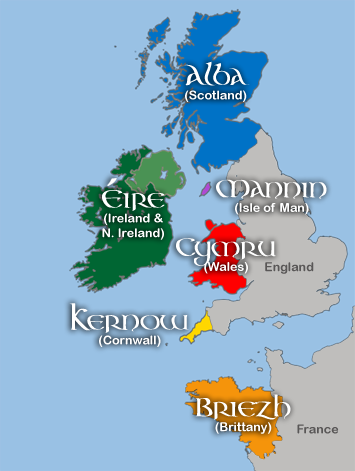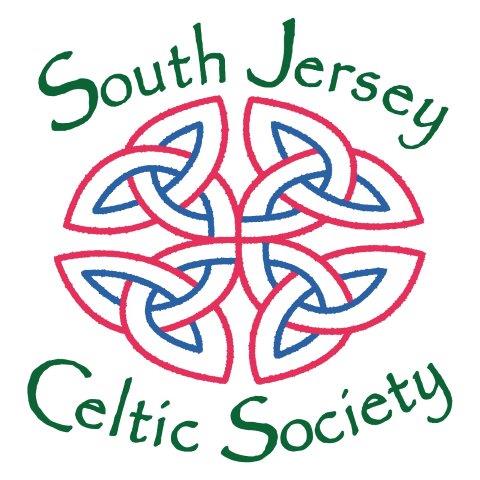

Ancient Celts and Modern Celts
From Wikipedia, the free encyclopedia (citations omitted).
The Celts (/ˈkɛlts/, occasionally /ˈsɛlts/, see pronunciation of Celtic) were an ethnolinguistic group of tribal societies in Iron Age and Medieval Europe who spoke Celtic languages and had a similar culture. Celtic refers to a family of languages and, more generally, means “of the Celts” or “in the style of the Celts”.
The Romans knew the Celts then living in what became present-day France as Gauls. The territory of these peoples probably included the Low Countries, the Alps and present-day northern Italy. Julius Caesar in his Gallic Wars described the 1st-century BC descendants of those Gauls. Eastern Gaul became the center of the western La Tène culture. In later Iron Age Gaul, the social organization resembled that of the Romans, with large towns. From the 3rd century BC the Gauls adopted coinage, and texts with Greek characters from southern Gaul have survived from the 2nd century BC. Under Caesar, the Romans conquered Celtic Gaul, and from Claudius onward, the Roman Empire absorbed parts of Britain. Roman local government of these regions closely mirrored pre-Roman tribal boundaries. The native peoples under Roman rule became Romanized and keen to adopt Roman ways. Celtic art had already incorporated classical influences, and surviving Gallo-Roman pieces interpret classical subjects or keep faith with old traditions despite a Roman overlay. The Roman occupation of Gaul, and to a lesser extent of Britain, led to Roman-Celtic syncretism. In the case of the continental Celts, this eventually resulted in a language shift to Vulgar Latin. By the 6th century, the continental Celtic languages were no longer in wide use.
By the mid-1st millennium AD, with the expansion of the Roman Empire and the Great Migrations of Germanic peoples, Celtic culture and Insular Celtic (Celtic languages that originated in the British Isles) had become restricted to Ireland, the western and northern parts of Great Britain (Wales, Scotland, and Cornwall), the Isle of Man, and Brittany. Between the 5th and 8th centuries, the Celtic-speaking communities in these Atlantic regions emerged as a reasonably cohesive cultural entity. They had a common linguistic, religious, and artistic heritage that distinguished them from the culture of the surrounding polities.
Today, the term Celtic generally refers to the languages and respective cultures of the Celtic nations (Ireland, Scotland, Wales, Cornwall, the Isle of Man, and Brittany). These are the regions where four Celtic languages are still spoken to some extent as mother tongues. The four are Irish Gaelic, Scottish Gaelic, Welsh, and Breton; plus two recent revivals, Cornish (one of the Brythonic languages) and Manx (one of the Goidelic languages). There are also attempts to reconstruct the Cumbric language (a Brythonic language from North West England and South West Scotland). Celtic regions of Continental Europe are those whose residents claim a Celtic heritage, but where no Celtic language has survived; these areas include the western Iberian Peninsula, i.e. Portugal, and north-central Spain (Galicia, Asturias, Cantabria, Castile and León, Extremadura). (See also: Modern Celts.)
A modern Celtic identity and revival emerged in Western Europe following the identification of the native peoples of the Atlantic fringe as Celts by Edward Lhuyd in the 18th century. The Celtic revival also led to the emergence of musical and artistic styles identified as Celtic. Music typically drew on folk traditions within the Celtic nations. Art drew on decorative styles associated with the ancient Celts and with early medieval Celtic Christianity, along with folk-styles. Cultural events to promote "inter-Celtic" cultural exchange also emerged.
Some of the most vibrant aspects of modern Celtic culture are music, song and festivals. Six nations tend to be most associated with a modern Celtic identity, and are considered 'the Celtic nations' -- Brittany, Ireland, Scotland, Wales, Isle of Man and Cornwall. It is these six nations that (alone) are considered Celtic by the Celtic League and the Celtic Congress amongst others. These organizations ascribe to a definition of Celticity based mainly upon language. In the aforementioned six regions, Celtic languages have survived and continue to be used to varying degrees in Ireland, Scotland, Wales, Isle of Man, Cornwall and Brittany. There are also Celtic nomads: Irish Travellers called "Pavee" that speak a language called Shelta that is a creole of Irish Gaelic and other languages and Indigenous Highland Scottish Travellers called "Tinkers" who speak a language called Beurla Reagaird that is an acrolect of Scottish Gaelic.
A number of activists on behalf of other regions/nations have also sought recognition as modern Celts, reflecting the wide diffusion of ancient Celts across Europe. Of these, the most prominent are Galicia/N. Portugal, Asturias and Cantabria. A Celtic language did not survive in Galicia/Northern Portugal (together Gallaecia), Asturias nor Cantabria, and as such they fall outside of the litmus test used by the Celtic League, and the Celtic Congress. Nevertheless, many organizations organized around Celticity consider that Galicia/Northern Portugal (Douro, Minho and Tras-os-Montes) and Asturias "can claim a Celtic cultural or historic heritage". These claims to Celticity are rooted in the long historical existence of Celts in these regions and ethnic connections to other Atlantic Celtic peoples (see Celtiberians, Celtici and Castro culture). Elements of Celtic music, dance, and folklore can also be found within England (e.g. Yan Tan Tethera, Well dressing, Halloween), and the Cumbric language survived until the collapse of the Kingdom of Strathclyde in about 1018. England as a whole comprises many distinct regions, and some of these regions, such as Cumbria, Lancashire, Western Yorkshire and Devon, can claim more Celtic heritage than others.
A significant portion of the populations of the United States, Canada, Australia, Argentina and New Zealand is composed of people whose ancestors were from one of the "Celtic nations". This concerns the Irish diaspora most significantly (see also Irish American), but to a lesser extent also the Welsh diaspora and the Cornish diaspora.
The emergence of folk-rock led to the creation of a popular music genre labelled Celtic music which "frequently involves the blending of traditional and modern forms, e.g. the Celtic-punk of The Pogues, the ambient music of Enya ... the Celtic-rock of Runrig, Rawlins Cross and Horslips." Pan-Celtic music festivals were established, notably the Festival Interceltique de Lorient founded in 1971, which has occurred annually since.
The birthdays of the most important Celtic Saints of Celtic Christianity for each Celtic nation have become the focus for festivals, feasts and marches: Ireland - Saint Patrick's Day; Wales - Saint David's Day; Scotland - Saint Andrew's Day; Cornwall - Saint Piran's Day; Isle of Man - St Maughold's Feast Day; and Brittany - Fete de la St-Yves and Grand Pardon of Sainte-Anne-d'Auray Pilgrimage.
From Wikipedia, the free encyclopedia (citations omitted).
The Celts (/ˈkɛlts/, occasionally /ˈsɛlts/, see pronunciation of Celtic) were an ethnolinguistic group of tribal societies in Iron Age and Medieval Europe who spoke Celtic languages and had a similar culture. Celtic refers to a family of languages and, more generally, means “of the Celts” or “in the style of the Celts”.
The Romans knew the Celts then living in what became present-day France as Gauls. The territory of these peoples probably included the Low Countries, the Alps and present-day northern Italy. Julius Caesar in his Gallic Wars described the 1st-century BC descendants of those Gauls. Eastern Gaul became the center of the western La Tène culture. In later Iron Age Gaul, the social organization resembled that of the Romans, with large towns. From the 3rd century BC the Gauls adopted coinage, and texts with Greek characters from southern Gaul have survived from the 2nd century BC. Under Caesar, the Romans conquered Celtic Gaul, and from Claudius onward, the Roman Empire absorbed parts of Britain. Roman local government of these regions closely mirrored pre-Roman tribal boundaries. The native peoples under Roman rule became Romanized and keen to adopt Roman ways. Celtic art had already incorporated classical influences, and surviving Gallo-Roman pieces interpret classical subjects or keep faith with old traditions despite a Roman overlay. The Roman occupation of Gaul, and to a lesser extent of Britain, led to Roman-Celtic syncretism. In the case of the continental Celts, this eventually resulted in a language shift to Vulgar Latin. By the 6th century, the continental Celtic languages were no longer in wide use.
By the mid-1st millennium AD, with the expansion of the Roman Empire and the Great Migrations of Germanic peoples, Celtic culture and Insular Celtic (Celtic languages that originated in the British Isles) had become restricted to Ireland, the western and northern parts of Great Britain (Wales, Scotland, and Cornwall), the Isle of Man, and Brittany. Between the 5th and 8th centuries, the Celtic-speaking communities in these Atlantic regions emerged as a reasonably cohesive cultural entity. They had a common linguistic, religious, and artistic heritage that distinguished them from the culture of the surrounding polities.
Today, the term Celtic generally refers to the languages and respective cultures of the Celtic nations (Ireland, Scotland, Wales, Cornwall, the Isle of Man, and Brittany). These are the regions where four Celtic languages are still spoken to some extent as mother tongues. The four are Irish Gaelic, Scottish Gaelic, Welsh, and Breton; plus two recent revivals, Cornish (one of the Brythonic languages) and Manx (one of the Goidelic languages). There are also attempts to reconstruct the Cumbric language (a Brythonic language from North West England and South West Scotland). Celtic regions of Continental Europe are those whose residents claim a Celtic heritage, but where no Celtic language has survived; these areas include the western Iberian Peninsula, i.e. Portugal, and north-central Spain (Galicia, Asturias, Cantabria, Castile and León, Extremadura). (See also: Modern Celts.)
A modern Celtic identity and revival emerged in Western Europe following the identification of the native peoples of the Atlantic fringe as Celts by Edward Lhuyd in the 18th century. The Celtic revival also led to the emergence of musical and artistic styles identified as Celtic. Music typically drew on folk traditions within the Celtic nations. Art drew on decorative styles associated with the ancient Celts and with early medieval Celtic Christianity, along with folk-styles. Cultural events to promote "inter-Celtic" cultural exchange also emerged.
Some of the most vibrant aspects of modern Celtic culture are music, song and festivals. Six nations tend to be most associated with a modern Celtic identity, and are considered 'the Celtic nations' -- Brittany, Ireland, Scotland, Wales, Isle of Man and Cornwall. It is these six nations that (alone) are considered Celtic by the Celtic League and the Celtic Congress amongst others. These organizations ascribe to a definition of Celticity based mainly upon language. In the aforementioned six regions, Celtic languages have survived and continue to be used to varying degrees in Ireland, Scotland, Wales, Isle of Man, Cornwall and Brittany. There are also Celtic nomads: Irish Travellers called "Pavee" that speak a language called Shelta that is a creole of Irish Gaelic and other languages and Indigenous Highland Scottish Travellers called "Tinkers" who speak a language called Beurla Reagaird that is an acrolect of Scottish Gaelic.
A number of activists on behalf of other regions/nations have also sought recognition as modern Celts, reflecting the wide diffusion of ancient Celts across Europe. Of these, the most prominent are Galicia/N. Portugal, Asturias and Cantabria. A Celtic language did not survive in Galicia/Northern Portugal (together Gallaecia), Asturias nor Cantabria, and as such they fall outside of the litmus test used by the Celtic League, and the Celtic Congress. Nevertheless, many organizations organized around Celticity consider that Galicia/Northern Portugal (Douro, Minho and Tras-os-Montes) and Asturias "can claim a Celtic cultural or historic heritage". These claims to Celticity are rooted in the long historical existence of Celts in these regions and ethnic connections to other Atlantic Celtic peoples (see Celtiberians, Celtici and Castro culture). Elements of Celtic music, dance, and folklore can also be found within England (e.g. Yan Tan Tethera, Well dressing, Halloween), and the Cumbric language survived until the collapse of the Kingdom of Strathclyde in about 1018. England as a whole comprises many distinct regions, and some of these regions, such as Cumbria, Lancashire, Western Yorkshire and Devon, can claim more Celtic heritage than others.
A significant portion of the populations of the United States, Canada, Australia, Argentina and New Zealand is composed of people whose ancestors were from one of the "Celtic nations". This concerns the Irish diaspora most significantly (see also Irish American), but to a lesser extent also the Welsh diaspora and the Cornish diaspora.
The emergence of folk-rock led to the creation of a popular music genre labelled Celtic music which "frequently involves the blending of traditional and modern forms, e.g. the Celtic-punk of The Pogues, the ambient music of Enya ... the Celtic-rock of Runrig, Rawlins Cross and Horslips." Pan-Celtic music festivals were established, notably the Festival Interceltique de Lorient founded in 1971, which has occurred annually since.
The birthdays of the most important Celtic Saints of Celtic Christianity for each Celtic nation have become the focus for festivals, feasts and marches: Ireland - Saint Patrick's Day; Wales - Saint David's Day; Scotland - Saint Andrew's Day; Cornwall - Saint Piran's Day; Isle of Man - St Maughold's Feast Day; and Brittany - Fete de la St-Yves and Grand Pardon of Sainte-Anne-d'Auray Pilgrimage.
⬅Core Celtic Territory, 600 BC
⬅Maximum Celtic Expansion, 275 BC
⬅6 Celtic Nations
←Celtic languages still widely spoken

